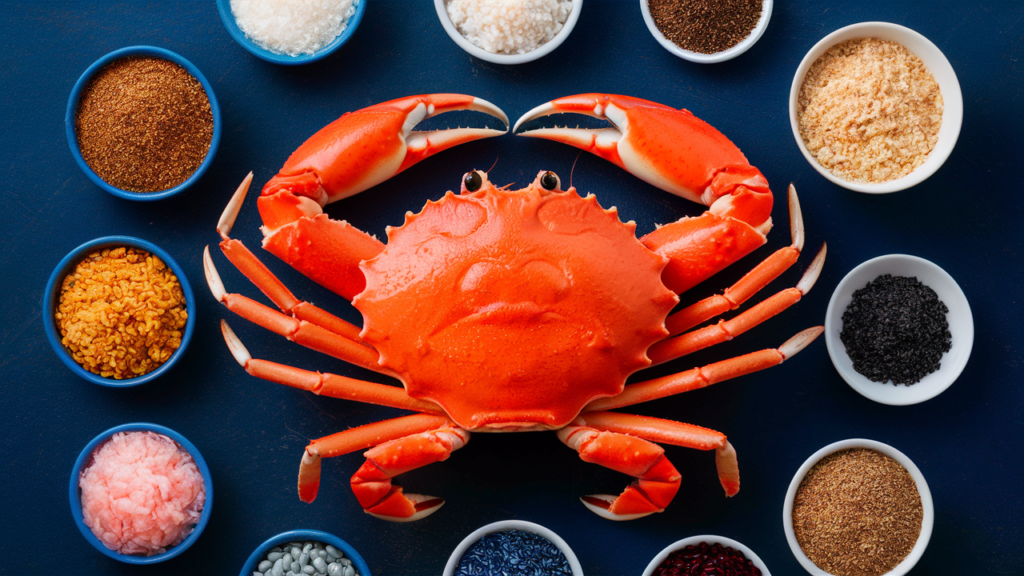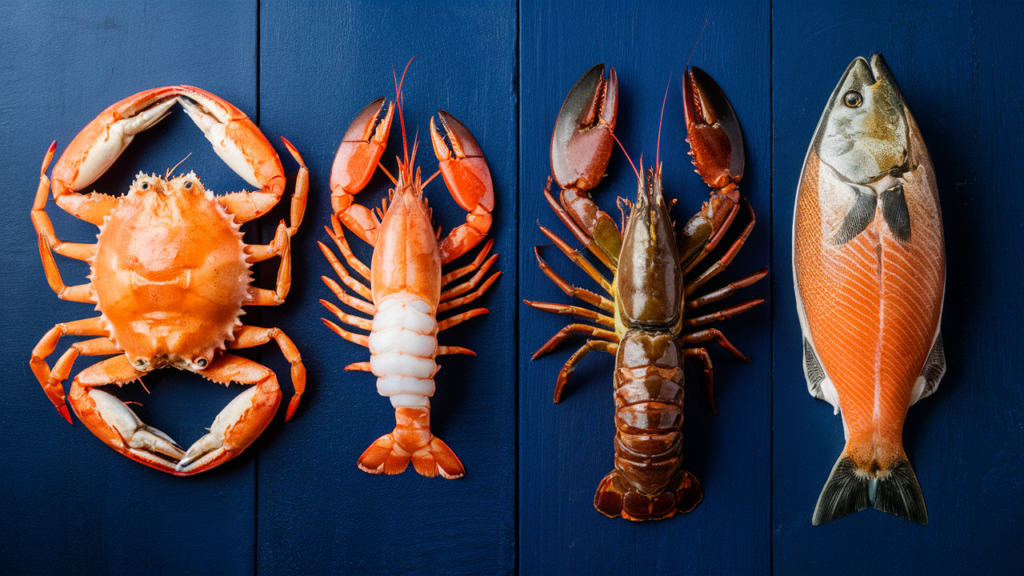Table of Contents
Crab meat has long been celebrated as a delicacy in numerous cuisines around the world, appreciated not only for its unique flavor but also for its impressive nutritional profile. As a powerful protein source, fresh crab offers a delightful seafood option that can elevate a variety of dishes. Its versatility allows it to be incorporated into a wide array of recipes, from classic crab cakes to vibrant seafood salads, making it a popular choice among culinary enthusiasts and health-conscious eaters alike.
The burgeoning interest in healthy eating has led many to seek out sources of protein that are not only nutritious but also appealing to the palate. Crab meat stands out in this regard, providing essential nutrients without compromising flavor. Its excellent source of high-quality protein, combined with low levels of fat and a wealth of vitamins and minerals, makes it a worthy consideration for anyone looking to enhance their diet. Moreover, with its low caloric content and abundance of omega-3 fatty acids, crab meat can significantly contribute to a balanced diet.
This blog post aims to delve into the various health benefits associated with crab meat, allowing readers to gain a comprehensive understanding of its nutritional value. By exploring this seafood’s nutrition in greater detail, we will showcase how it can serve as a healthy alternative to traditional protein sources. Furthermore, we will provide an array of recipes that are both tasty and health-conscious, encouraging readers to incorporate this versatile ingredient into their meal planning. We invite you to continue reading to discover the many advantages of crab and how it can fit seamlessly into your healthy eating habits.
Nutritional Profile of Crab Meat

Crab meat is increasingly recognized as a powerful protein source, providing a host of essential nutrients that contribute to a healthy diet. Primarily, it is known for its high protein content, which is crucial for muscle growth, tissue repair, and overall bodily maintenance. Specifically, a 3.5-ounce serving of fresh crab can contain upwards of 20 grams of protein, making it an excellent option for those seeking to enhance their protein intake without the accompanying fats found in many land-based meats.
In addition to protein, crab is relatively low in calories, which is ideal for weight-conscious consumers. A typical serving has less than 100 calories, making it a nutritious alternative to higher-calorie protein sources. The fat content is also notably low, predominantly comprising healthy unsaturated fats, which can contribute to cardiovascular health when consumed in moderation.
Furthermore, its nutritional makeup includes a variety of vitamins and minerals. It is rich in vitamin B12, vital for nerve function and red blood cell production, while its mineral content features an impressive range of nutrients such as selenium, copper, and zinc. These micronutrients play significant roles in antioxidant protection, immune function, and metabolic processes.
When compared to other seafood and meat options, crab stands out due to its balanced nutritional profile. For instance, while tuna and salmon are known for their omega-3 fatty acids, crab offers a unique array of benefits with its lower fat content and higher levels of certain vitamins and minerals. Incorporating fresh or lump crab into your diet can provide a delicious and healthy way to meet your nutritional needs effectively.
Health Benefits of Crab Meat
Crab meat is not only a delicious addition to various dishes, but it also serves as a powerful protein source with a myriad of health benefits. One of the most notable advantages of this seafood is its high protein content, which is essential for muscle growth and repair. The amino acids found in crab help develop lean muscle mass, making it an excellent choice for individuals aiming to enhance their fitness levels. Moreover, its low-calorie and low-fat profile positions crab as a favorable option for those looking to manage their weight effectively.
In addition to its protein benefits, crab is rich in omega-3 fatty acids, which play a crucial role in supporting heart health. These healthy fats help to reduce inflammation and lower the risk of chronic diseases such as heart disease and arthritis. Furthermore, this seafood is an outstanding source of vitamin B12, which is vital for energy metabolism and optimal brain function. Adequate levels of this essential vitamin can prevent fatigue and support cognitive health, making it a smart dietary choice.
Another significant nutrient present in crab is selenium. This trace mineral is well-known for its antioxidant properties, which help combat oxidative stress in the body. Research has demonstrated that adequate selenium intake can support immune function and may even reduce the risk of certain types of cancer. These health benefits underscore the importance of including crab recipes in one’s diet, allowing individuals to enjoy not only its exquisite taste but also its rich nutritional profile.
Real-life examples, including studies linking the consumption of crab to improved heart health and enhanced cognitive function, further support the incorporation of this delicacy into daily meals. The versatile nature of crab allows for a variety of culinary applications, ensuring that individuals can benefit from its nutrition while satisfying their taste buds.
Comparing Crab Meat to Other Seafood Options

When considering the nutritional benefits of seafood, crab meat stands out as a powerful protein source in comparison to other popular options such as shrimp, salmon, and tuna. Each of these seafood types serves as a staple in many diets, but their nutritional profiles can vary significantly, making it essential for consumers to make informed choices about seafood consumption.
Crab is particularly valued for its high protein content. A standard serving of fresh crab contains approximately 20 grams of protein, which is comparable to shrimp’s 24 grams per serving. While shrimp may have a slightly higher protein concentration, crab also offers a rich array of essential vitamins and minerals, including vitamin B12, selenium, and zinc, enhancing its reputation as a healthy seafood alternative. In contrast, salmon provides health benefits primarily through its omega-3 fatty acids, which are essential for heart health—an area where crab is less prominent.
Tuna, while known for its high protein levels—around 25 grams per serving—sometimes found in canned varieties, may also come with higher mercury levels, which can pose health risks. Hence, those consuming tuna should consider these potential drawbacks. This aspect further emphasizes the benefits of choosing lump crab meat, which not only boasts a competitive protein content but also offers the advantage of lower mercury exposure compared to larger fish like tuna.
In terms of taste, crab meat is often celebrated for its sweet, delicate flavor that complements a range of crab meat recipes, ensuring versatility in the kitchen. It can be enjoyed in dishes ranging from crab cakes to cold salads, making it a favorite among seafood lovers. Thus, crab meat emerges as an appealing choice, combining health benefits, flavor, and versatility, positioning it favorably in the array of seafood options available to consumers.
Potential Health Risks and Considerations
While crab meat is celebrated for its high protein content and versatility in culinary applications, it is essential to be aware of potential health risks and considerations associated with its consumption. One significant concern is the possibility of allergic reactions. Some individuals may have shellfish allergies, which can result in severe symptoms ranging from hives and stomach cramps to anaphylaxis. It is critical for those with known allergies to avoid crab meat and seek alternatives that suit their dietary restrictions.
Another important consideration is the sustainability of crab sourcing. As with many seafood products, overfishing and unsustainable practices can exacerbate environmental issues. Consumers should prioritize purchasing fresh crab meat from sustainable sources, ideally those that adhere to responsible fishing practices. Certifications from organizations such as the Marine Stewardship Council indicate that the crab has been sourced ethically, which contributes not only to individual health but also to the health of marine ecosystems.
Additionally, potential contaminants such as mercury pose a risk, especially in larger crab species. Mercury exposure can lead to serious health issues, particularly for vulnerable groups such as pregnant women and young children. It is advisable to limit consumption of larger crab varieties and prioritize lump crab meat from reputable suppliers that undergo regular testing for contaminants.
To ensure the safe consumption of crab, individuals should follow these guidelines: purchase from trusted vendors, check for freshness and signs of spoilage, and consume in moderation. Being mindful of these health considerations allows consumers to enjoy the nutritional benefits while minimizing risks. A well-informed approach to selecting high-quality crab can enhance one’s dining experience without compromising health.
Incorporating Crab Meat into a Healthy Diet
Integrating crab meat into a balanced diet presents an excellent opportunity to enjoy a delicious and nutritious food source. With its high protein content and unique flavor, fresh crab meat can be added to various meals that cater to different tastes and dietary preferences. One popular approach is to use lump crab meat in salads. A refreshing crab salad, made with diced vegetables and a light vinaigrette, can serve as a wholesome lunch option enriched with crab meat nutrition.
Another delightful way to incorporate crab meat is by preparing crab cakes. Using fresh crab meat, combined with whole-grain breadcrumbs and seasonings, these cakes can be baked or grilled for a healthier alternative to traditional frying. This preparation method helps not only retain the delicate flavors of the lump crab meat but also enhances its nutritional profile. Serving crab cakes with a side of steamed vegetables or a green salad can create a well-rounded meal.
For those looking to add crab meat to comforting dishes, consider incorporating it into pasta or risotto. Dishes such as crab linguine, where the fresh crab meat is tossed with whole wheat pasta, garlic, and olive oil, exemplify how crab meat recipes can bring a gourmet touch to everyday cooking while maintaining health benefits. Furthermore, methods such as steaming or grilling crab meat can preserve its natural taste and nutrition without adding excessive fats.
Including crab meat in soups is another scrumptious idea. A creamy crab bisque or a lighter crab broth can offer a satisfying option for dinner. Not only does this approach provide warmth and comfort, but it also ensures that the crab meat retains its integrity within the dish. By preparing meals that highlight crab meat, individuals can effortlessly enhance their diet while indulging in delightful flavors.
Tips for Enjoying Crab Meat in a Healthy Way

Crab meat, known for its delicate flavor and versatility, can be an excellent addition to a balanced diet when prepared thoughtfully. To enjoy this delectable seafood while maintaining overall health, consider a few key tips that enhance both the nutritional profile and the culinary experience of fresh crab meat.
Firstly, choosing healthy cooking methods is essential. Steaming or baking lump crab meat instead of frying can significantly reduce added fats and calories, preserving the meat’s natural flavors and vital nutrients. These methods not only promote a lighter dish but also highlight the rich taste of crab without overwhelming it with excess oils or heavy sauces.
Pairing crab meat with nutritious sides is another effective strategy. Opt for roasted or steamed vegetables, which provide fiber and various vitamins, complementing the crab’s protein content. Whole grains, such as quinoa or brown rice, can also be excellent partners, offering additional nutrients and promoting satiety. Together, these components can create a well-rounded meal that is both satisfying and healthy.
When it comes to flavor, getting creative with crab meat recipes can lead to low-calorie, high-flavor dishes. Consider making a crab meat salad with a light vinaigrette, laden with fresh herbs, citrus, or a dash of spicy mustard. This approach not only enhances the flavors of the crab but also ensures that the dish remains low in calories, making it a guilt-free option for any meal. Emphasizing fresh ingredients and bold seasonings can elevate the dish without relying on heavy sauces or excessive calories.
By adopting these healthy practices, you can enjoy crab meat as a delicious source of protein while reaping the nutritional benefits it provides. Integrating these tips into your cooking routine allows for a satisfying culinary experience that aligns with health-conscious choices.
Conclusion
Crab meat stands as a robust protein source, offering a myriad of health benefits that make it an excellent addition to any diet. Throughout this blog post, we have highlighted the exceptional nutritional profile of fresh crab meat, which is low in calories yet rich in high-quality protein. The various forms of this seafood, including lump crab meat, provide essential vitamins and minerals that support overall well-being.
We have also explored crab meat recipes that showcase its versatility in the kitchen, demonstrating how this ingredient can elevate everyday meals. From crab cakes to salads, the possibilities are endless, allowing individuals to experiment and discover flavors that excite their palate. Incorporating crab meat into your meals not only enhances taste but also contributes significantly to your nutritional intake.
Moreover, the health benefits of crab meat nutrition cannot be understated. It is a source of omega-3 fatty acids, which are known for their positive effects on heart health. Additionally, crab meat contains important nutrients like vitamin B12 and selenium, which aid in maintaining energy levels and overall bodily functions. Therefore, by considering crab meat as a regular part of your diet, you are making a conscious decision to support your health while enjoying delicious meals.
We encourage you to try crab meat in your next meal and explore various recipes that highlight this powerful protein source. Share your culinary creations and experiences with friends and family, inviting them to discover the delicious and nutritious world of crab meat. Whether you are a long-time fan or new to this ingredient, embracing crab meat can undoubtedly enrich your dietary habits.

